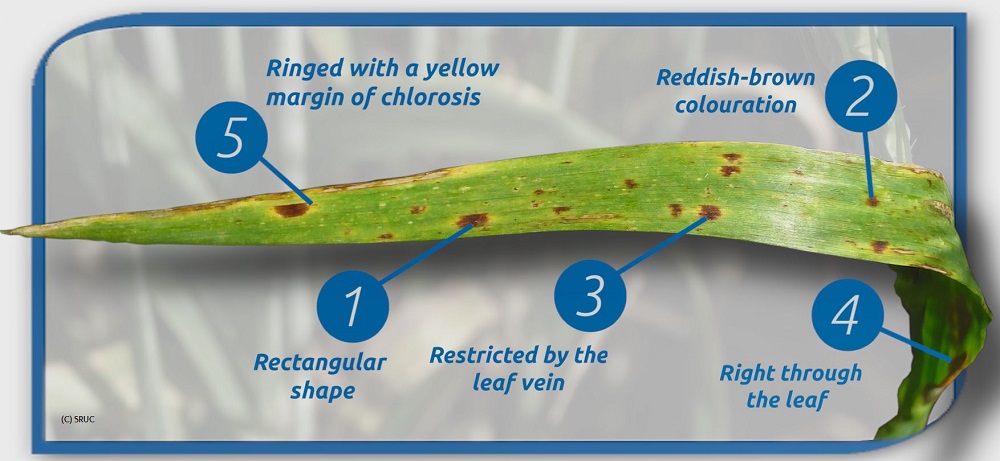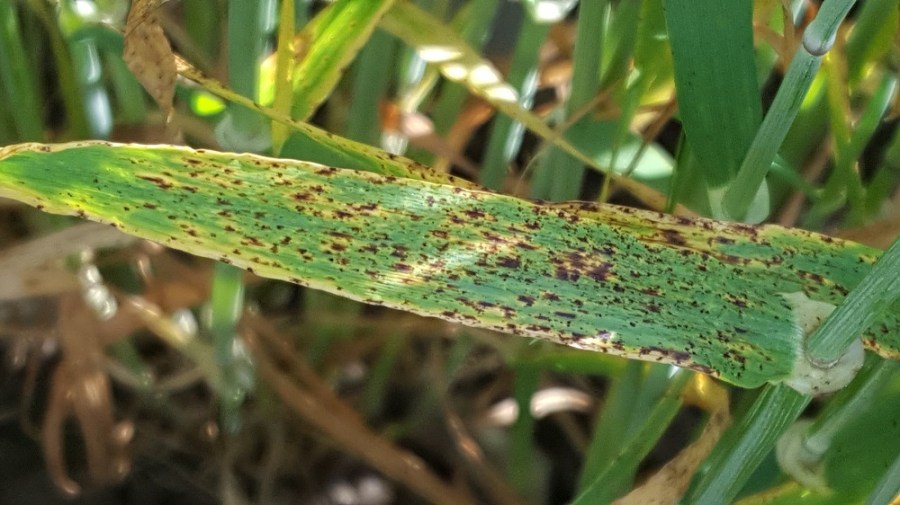Ramularia in barley
 With mounting resistance to single-site chemistries making the control of ramularia in barley increasingly difficult to achieve, Adama is working with CPM to highlight the importance of including a multi-site fungicide in spring spray programmes – not only to ensure crops are adequately protected, but also to prolong the effective lifetime of at-risk products.
With mounting resistance to single-site chemistries making the control of ramularia in barley increasingly difficult to achieve, Adama is working with CPM to highlight the importance of including a multi-site fungicide in spring spray programmes – not only to ensure crops are adequately protected, but also to prolong the effective lifetime of at-risk products.
Lurking unseen in barley crops, ramularia has developed resistance to most chemistry and shows its spots only late in the season. CPM explores how to keep a lid on infections.
Ramularia’s ability to mutate and evolve resistance to fungicide chemistry makes it a problem.
By Tom Allen-Stevens
Ramularia was only acknowledged as a disease in barley in 1998. But in the relatively short space of time since, it’s passed from being a minor disease to a major one, and there are probably more unanswered questions raised about it than there are solutions.
For Dr Neil Havis of SRUC, one of the major challenges ramularia poses is its unprecedented ability to mutate and evolve resistance to major fungicides – a good understanding of the pathogen is therefore vital. With chlorothalonil (CTL) falling out of the picture this spring, Adama’s David Roberts believes a planned, programmed approach to its control is the best way forward.
What is ramularia?
Caused by the pathogen Ramularia collo-cygni, the disease affects both winter and spring barley but lives within the host and usually shows no visible symptoms until after flowering – it’ll only appear earlier if the crop is stressed or on senescing leaves.

Notoriously difficult to identify, growers are advised to use the ‘5Rs’.
It can be a notoriously difficult disease to identify correctly, and growers are advised to use the ‘5Rs’ to identify symptoms.
Lesions are typically found on the top three leaves later in the season, with the majority on leaf two. Abiotic stress can easily be misidentified as ramularia if the 5Rs aren’t closely followed. It can also be readily confused with net blotch, although ramularia doesn’t run up the veins, so monitoring how the disease develops will often reveal which it is.
Infection can be carried into the crop on the seed, and the fungus moves asymptomatically in the crop through the growing season. The huge diversity of the pathogen population suggests a high level of sexual recombination takes place late in the growing season, giving diversity levels similar to septoria in wheat. What’s more, the fungus mutates readily under ultra-violet radiation, and this ability to adapt and evolve is believed to be the cause of the high level of resistance ramularia has to key fungicides.
Warm, wet conditions encourage the disease to spread and the symptoms are thought to be produced by a toxin the fungus produces within the leaf, rubellin D, which is light activated. So under certain light conditions – prolonged, intensive sunlight being ideal – this toxin causes oxidative stress, leading to plant cell damage resulting in typical leaf symptoms. A plant already under stress will exacerbate these symptoms, so water-logged, or drought-stressed crops, those with nutrient deficiencies or suffering other diseases are likely to be most affected by ramularia.
How important is it?
Once believed to be a disease found only in the north of Britain and perhaps in the West, ramularia is now widespread across the UK.
In terms of damage, however, as it’s a disease that shows itself late in the season, a high infestation rarely takes more than 10-15% of yield. The real yield robber in barley remains rhynchosporium, that’ll knock up to 50% off yield potential if allowed to develop unchecked. But it’s not just yield – ramularia stresses a barley crop causing thin grains, resulting in rejections if destined for a quality malting market.
Why is it a problem?
Ramularia’s ability to mutate and evolve resistance to fungicide chemistry makes it a problem. This was first picked up in Germany in 2015.
In 2017, conditions across the UK were particularly conducive to the disease. This coincided with the widespread breakdown of efficacy of azoles and SDHIs – for both major groups to go down at the same time is unprecedented. This combination of prevalence and resistance put ramularia to the top of the agenda as a pathogen in barley crops.
While most single-site chemistry is all but ineffective against ramularia, multi-sites provide protectant activity against the disease, which include CTL and folpet. Independent trials have always shown CTL to be the most effective fungicide, but its loss of approval on 20 May this year will take it out of most control programmes at the traditional T2 timing for winter barley and almost certainly for spring-sown crops.
The new triazole Revysol (mefentrifluconazole) has been shown to have good efficacy. But as a single-site fungicide it cannot be relied on for long term control and should be partnered with a multi-site to slow down the development of resistance.
How can its impact be minimised?
Varieties do differ in their response to ramularia, and these are significant until crops reach around GS80. After that, differences are less clear. But breeders have not been selecting for resistance to ramularia, so no variety on the current AHDB Recommended List can be classed as either weak or strong.
What’s more, there are no RL scores for the disease – previous attempts to score varieties at RL trial sites have been abandoned as it’s hard to agree a standard protocol. While this is under review, it effectively means growers cannot rely on varietal resistance, and that’s a serious omission from the toolbox.
Healthy crops, even if infected, are far less likely to suffer symptoms of ramularia than those under stress – the health of the crop has a greater influence than with other diseases. This increases the importance of ensuring good soil conditions at planting and the right balance of available nutrients throughout the season.
There’s potential for elicitors to build plant defences. These are products formulated in a way to trick a plant into thinking it’s under attack from disease. Trials into these products are underway at SRUC, and initial results indicate they can allow a fungicide rate to be halved for the same level of control. Biologicals and biostimulants may offer similar benefits, and again trials are underway.
One of the challenges of ramularia, however, is that symptoms will not be seen until after GS70, by which time it’s too late to treat a crop. There will be other disease priorities at key fungicide timings, so the only way to manage the disease is to plan overall management carefully to keep the crop healthy and to keep it well protected through the use of multi-site chemistry.
How can it be controlled without CTL?
According to industry market data, the area of barley treated with multi-site chemistry to control ramularia more than doubled between 2017 and 2019. With widespread resistance to single-site chemistry, CTL has proven the most effective treatment to control ramularia, but cannot be used on crops after 20 May this year. Alternative choices are limited, although folpet is approved for use in barley.
Folpet offers good protection to a range of cereal diseases and, as a multi-site fungicide, has no known resistances or insensitivities. Independent trials carried out at Oak Park in Ireland indicate a programmed approach, with folpet used at both the T1 and T2 spray timing gives the best results.
Work carried out by Silsoe Spray Applications Unit has investigated whether the uptake of some modern fungicides is impeded when tank-mixed with multi-site chemistry. While this found that there was a notable effect with CTL on some chemistry, no such antagonism existed where folpet was used.
Folpet has also been found to help protect azole chemistry and prolong its effective life. ADAS has carried out modelling work on septoria to assess the relative efficacy of repeated use of epoxiconazole with and without folpet, with results showing the multi-site doubled the effective life of the triazole. This work has since been repeated using prothioconazole with the SDHI fluxapyroxad and produced similar results. While no specific trials have been undertaken with ramularia, the pathogen behaves in a very similar way to septoria.
What strategy works best?
While many growers will use up existing stocks of CTL this year to protect crops from ramularia, it’s unlikely this option will be available at T2, which is where Arizona, containing folpet, can be used at the recommended rate of 1.0 l/ha. Folpet can also be safely sequenced with CTL.
The most effective strategy against ramularia is to keep crops healthy and in a protective state. Folpet offers the best on-going option to ensure this, and also helps prolong the life of other chemistry. A typical programme offering best results across a range of barley diseases would see Arizona applied at 1.0 l/ha at both the T1 and T2 timings tank-mixed with an SDHI/azole such as Siltra Xpro (bixafen+ prothioconazole).
Multi-sites remain the cornerstone of barley disease control
Like many agronomists, Suffolk-based Laura Buckingham has been caught off-guard by ramularia. “It’s one of those diseases we’ve largely ignored, and we haven’t been very good at identifying it,” she admits.
“In the past, a half decent fungicide programme has kept a lid on the disease, but with resistance building, it’s now far more of a priority.”
An AICC member, Laura looks after around 400ha of arable crops in Suffolk in addition to her role as arable manager at Fram Farmers. It was a crop of KWS Orwell that made her rethink the significance of the disease. “I noticed an infection in the canopy post-flowering and thought at first it was net blotch. This struck me as odd as the crop had received a good fungicide programme.”
About 10-15% of the leaf was infected, with worst symptoms showing on leaf two. Closer inspection confirmed it was ramularia, and although she knew she’d “missed the boat” on treating for it, it was important to keep the level of infection monitored. “It’s worth knowing for crops that may be used for seed or heading to quality markets,” she notes.
Laura’s strategy to manage ramularia is firstly to keep the crop healthy and then to include a multi-site fungicide at both spray timings. “Winter barley always responds well to trickle feeding throughout the season, and that helps hold back ramularia as the crop is less stressed,” she says. “We’ve all learnt the lessons of not including a multi-site fungicide. It’s important to get spray timings right, too.”
Her standard programme on winter barley is to apply 0.6 l/ha of Siltra at T1, dropping this back to 0.4 l/ha at T2, depending on overall disease pressure. On spring crops, the rate at T1 is shaved to 0.5 l/ha. Until now, she’s tank-mixed CTL at 1 l/ha at both timings, but has been exploring other options. “There’s been a question mark over CTL’s continued approval for use for quite some time and it’s important to know where to go,” she notes.
So she’s been monitoring the performance of folpet used in AICC trials and has used it as part of the programmes she’s advised, often switching folpet in at one of the spray timings.
“The multi-site should really be considered the cornerstone of spray programmes – you start with it and then build the rest of the tank-mix around it depending on the disease priorities. It’s crucial to keep timings correct, and with ramularia particularly important to keep the crop stress-free. But with CTL falling away, I’m as confident as I can be in folpet, and it will remain an essential element of the tank-mix to protect other actives,” notes Laura.
Ramularia in barley: top tips
- Keep the crop healthy – Plan establishment and management so that the barley is free of stress.
- Keep it in a protected state – use multi-site chemistry to help prevent disease and prolong life of single-site actives.
- Use a programmed approach – Using folpet at both T1 and T2 spray timings offers best on-going results.
Sponsor message
Arizona is a unique multi-site protectant fungicide containing straight folpet at 500g/l. In addition to providing activity against rhynchosporium in barley, it also provides useful protection against ramularia and has the added benefit of not interfering with the activity of partner azoles or SDHIs.
A well-timed T1 spray (typically GS30-32 in winter barley or GS25-30 in spring barley) is key to protecting the crop at tillering/stem extension and should be followed by a subsequent treatment at T2 (typically GS39-49) to provide continued protection. Arizona can also be used at T3 (GS49-59) but growers must be aware that a maximum total dose of 3.0 l/ha is allowed.
For more information, or to subscribe to Adama’s disease management hub, go to www.adama.com/uk




